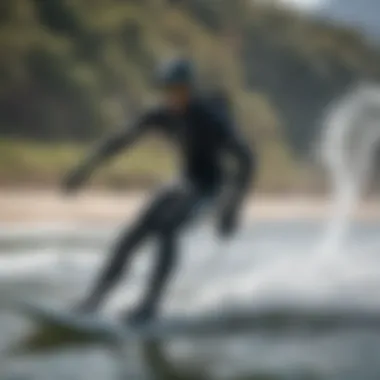Top Cold Water Wetsuits for Kiteboarding Adventures


Intro
As the sun sets and the temperature drops, 💨 kiteboarding enthusiasts often find themselves at a crossroads. Do you let the chill in the air keep you from the thrill of the waves? Or do you gear up in a proper wetsuit to take on the elements? For those who thrive on adventure even in cold waters, selecting the right wetsuit becomes crucial. The market is flooded with options, yet only a handful truly meet the diverse needs of kiteboarders navigating the frigid waters. In this guide, we’ll explore essential features to consider when choosing a cold-water wetsuit, suitable brands, and your best bets based on both user experiences and expert evaluations.
When it comes to kiteboarding in colder conditions, some might say you are only as good as your gear. This isn't too far off the mark. A poorly fitting wetsuit can turn a promising ride into an uncomfortable experience. Understanding how materials, fit, and proper maintenance affect performance will be key to enhancing your kiteboarding escapades.
As we navigate through the nuances of wetsuits, we’ll delve deeper into the vital components that contribute to a dependable cold-water wetsuit, offering insights tailored for kiteboarders, instructors, and gear aficionados alike. Stick around as we unpack techniques that can elevate your kiteboarding skills beyond the surf and into the chill.
Techniques
Beginner Kiteboarding Techniques
For newcomers to kiteboarding, mastering basic techniques is imperative. Getting your footing right on the board while managing the kite can be a daunting task! Focus on these foundational skills:
- Launching and Landing the Kite: Always launch with the wind blowing over your head and ensure you have enough space.
- Water Start: Emerging from the water with a controlled pull from the kite should be practiced in familiar settings.
- Riding Upwind: This is crucial for staying in the sweet spot of the water. You want to come back to your starting point after the ride.
Advanced Freestyle Maneuvers
Once you got the basics, it's time to kick things up a notch. Advanced maneuvers can impress your fellow riders and elevate your style. These include:
- Kite Loops: A powerful technique that takes practice and a good understanding of kite control.
- Handle Passes: An elegant move that requires timing and a fair bit of trust in your kite.
- Backrolls and Frontrolls: Sharpen your skills for aerial tricks.
Navigating through cold waters requires not just skill, but a keen sense of the equipment you’re wearing, as well. The better your wetsuit fits, the more confident you'll feel trying new techniques!
Tip: Always practice in spots you know well if you're trying new moves in cold water, especially if you’re wearing a thick wetsuit.
"The right gear can turn a frigid day into an unforgettable kiteboarding journey. Your wetsuit is just as essential as your kite and board."
Stay tuned as we explore the critical aspects of wetsuit selection in our next section!
Understanding Cold Water Wetsuits
In the world of kiteboarding, enthusiasts often find themselves navigating the choppy waters of colder climates. It’s crucial to understand the function and significance of cold water wetsuits. These specialized garments not only serve as a protective barrier against the biting chill of the water, but also play a pivotal role in enhancing comfort and performance on the board.
Cold water wetsuits have evolved significantly, driven by advancements in materials and design. Their primary purpose is to trap a thin layer of water against your skin. The body warms this water, creating an insulating layer that shields you from the cold and allows for greater ease of movement in the water. No one wants to feel like a popsicle while trying to navigate waves; hence, selecting the right wetsuit becomes paramount.
Once you grasp how cold water wetsuits perform, it becomes evident that the right fit and features can make or break your kiteboarding experience. This article will dissect the various attributes that comprise an optimal wetsuit, including material composition and thickness, as well as how these factors correlate directly to on-water performance.
Understanding cold water wetsuits, therefore, is about knowing how these elements integrate to create safety and efficacy during your kiteboarding adventures.
The Importance of Wetsuits in Cold Water
When you're kiteboarding in chilly waters, a wetsuit isn’t just a luxury; it’s a necessity. The water might be too zippy for comfort without proper gear. A well-fitted wetsuit provides thermal regulation, which is essential for maintaining body temperature. When your body temperature dips too low, your muscles can become sluggish, affecting your performance on the board.
Wetsuits protect against both hypothermia and the potential nicks or scrapes from the surf, ensuring that your session stays safe. Moreover, they allow you to extend your riding season, keeping you in the water when others are packing up for warmer conditions. In essence, a high-quality cold water wetsuit transforms possible trepidation about the elements into a confident engagement with the waves.
- Thermal protection: Traps warmth and keeps you cozy.
- Physical insulation: Shields against scrapes and cuts.
- Extended riding capabilities: Allows for longer sessions throughout seasons.
Just like putting on sunscreen for a sun-soaked beach day, slipping into a wetsuit prepares you for the cold, equipping you with everything you need to enjoy the kiteboarding experience to the fullest.
How Temperature Affects Kiteboarding Performance
The temperature of the water isn’t just a number on a thermometer; it dictates your entire kiteboarding outing. Different temperatures can lead to varying physical responses from our bodies. When the water is frigid, your energy levels may dip, affecting your agility and reaction times. This can directly impact your ability to maneuver effectively on the board.
Cold water affects muscle function and coordination. As the temperature drops, the muscles may lose their elasticity, making them less responsive. That’s one reason a proper wetsuit is critical. It doesn’t just keep you warm; it also helps maintain optimal performance by allowing you to stay somewhat mobile and agile, even when the conditions are far from perfect.
- Comfort Matters: Being shivery limits focus and function.
- Mental Factors: Cold can bring stress; a good wetsuit mitigates the discomfort.


Thus, the right cold water wetsuit becomes more than just a piece of gear; it’s the linchpin for enjoying cold water kiteboarding and maximizing performance. Understanding how temperature plays into this equation highlights why you should prioritize wetsuit selection.
“You make your own weather. The secret is to embrace the cold and let your wetsuit be your armor.”
The effect of temperature on your body and performance cannot be overstated in kiteboarding culture. The right wetsuit allows you to ride longer, reducing the mental strain of cold exposure and making way for an exhilarating experience on the water.
Key Features of Cold Water Wetsuits
When it comes to kiteboarding in frigid waters, the choice of wetsuit can make or break your experience. It’s not just about staying warm, but also how effectively you can manoeuvre and perform on the board. Understanding the key features of cold water wetsuits is essential for kiteboarding enthusiasts. These characteristics determine the suit's insulation properties, flexibility, and overall comfort, which in turn affects one's enjoyment and performance on the water.
Material Composition
Neoprene Variants
The material from which a wetsuit is made plays a pivotal role in its performance. Neoprene, for instance, dominates the wetsuit market because of its unique insulating properties. Regular neoprene is thicker and more durable, suitable for extreme conditions, while super-stretch neoprene is thinner yet offers excellent flexibility. This flexibility can be a game-changer when you’re navigating gusty winds or choppy waters.
One standout feature of neoprene is its resistance to cold water, essentially forming a barrier that keeps your body warm while also allowing some movement. However, it's worth noting that while thicker neoprene provides more insulation, it might sacrifice some ease of movement. So, kiteboarders need to balance warmth and flexibility based on their specific needs.
Seam Construction
Another critical aspect is the seam construction of the wetsuit. Seams can be stitched, glued, or even tapped depending on the design. Flatlock seams, for example, are comfortable but can let in some water, which is not ideal for cold conditions. On the other hand, blind-stitch seams are less porous, sealing off water but can feel stiffer.
Seam construction can greatly affect durability as well. Strong seams can resist wear and tear from vigorous activity, enhancing the lifespan of the wetsuit. It's essential to consider how well a wetsuit is put together, as poorly constructed seams can lead to leakage, turning your kiteboarding session from exhilarating to uncomfortable very quickly.
Thickness and Insulation
Optimal Thickness for Different Conditions
The thickness of a wetsuit is indeed a delicate balancing act. Generally, cold water wetsuits vary from 3mm to 6mm in thickness. For those chilly sessions in waters hitting the low 50s, a thicker wetsuit can provide the necessary insulation without feeling too cumbersome.
For kiteboarding, ideally, you need a suit that's not just thick, but also allows for quick movements; a few details separate an enjoyable experience from an uncomfortable one. When the water temperature dips too low, there's no wiggle room—you need optimal thickness to fend off the cold, but going too thick can hinder your movements during tricks or turns. It’s about making sure you’re adequately insulated while keeping agility intact.
Thermal Linings
Thermal linings are another defining factor in cold water wetsuits. They’re designed to enhance heat retention while improving comfort. Choose a wetsuit with thermal linings made from materials like fleece or plush for added warmth without unnecessary bulk. These linings work by trapping a layer of water that generates heat against your body, significantly reducing the chill as you paddle out.
The downside? Thermal linings can retain moisture if the wetsuit isn’t dried properly, which may lead to unpleasant odours over time. Keeping this in mind, thorough care and maintenance after each use are crucial for extending a suit's life and ensuring a pleasant experience each time you hit the water.
Fit and Comfort
Different Cut Styles
The fit of your wetsuit influences both comfort and function. Different cut styles—from shorties to full-length suits—cater to varying preferences and conditions. Paddle suits with arms and legs can maximize warmth, whereas shorties are ideal for slightly warmer days.
Specific cuts may also provide better movement. A back zip or chest zip design can affect how easily you can take the suit on and off, which plays a vital role post-session. Finding the right cut is about understanding your own comfort during usage, as it affects everything from freedom of movement to warmth retention.
Adjustability Features
Lastly, adjustability features such as ankle and wrist seals can drastically influence your comfort level in cold water. Some wetsuits come equipped with velcro straps or other secure closing mechanisms to ensure a snug fit around these areas, preventing water from trickling in.
However, while a tighter seal is beneficial for blocking cold water, it could feel restrictive after long use. So while shopping for a wetsuit, it is crucial to ensure that the adjustability options meet personal preferences without causing discomfort during prolonged wear.
Top Brands for Cold Water Wetsuits
When it comes to kiteboarding in chilly waters, the choice of wetsuit can significantly influence performance and comfort. This section highlights leading brands that have established themselves as trusted names in the industry due to their quality, innovation, and user satisfaction. Understanding these brands helps kiteboarding enthusiasts make informed decisions tailored to their needs. Each brand brings unique flavors and advantages, enhancing the overall kiteboarding experience.
Leading Wetsuit Manufacturers
O'Neill
O'Neill has carved a distinct niche in the wetsuit market, renowned for its commitment to producing high-quality neoprene suits. Their wetsuits often feature fine-tuned thermal insulation, making them ideal for cold water conditions. A standout characteristic of O'Neill is its Technobutter neoprene, which offers increased flexibility while retaining warmth. This unique material is a game changer; it allows kiteboarding enthusiasts to move freely while still being shielded from the bite of cold water. However, some users have noted that the price point can be a bit steep, which may not suit everyone's budget.


Rip Curl
Rip Curl is another heavyweight name, celebrated for its innovative designs and attention to detail. One of the key selling points of Rip Curl wetsuits is their E4 neoprene, which provides exceptional stretch and thermal performance. This means that riders can expect better mobility and warmth without feeling constrained. A unique feature of Rip Curl is its Black Hole thermal lining, which helps retain body heat. Many users rave about the comfort and effectiveness in cold waters, although a few have mentioned durability issues over extended periods.
Quiksilver
Quiksilver stands as a popular choice among kiteboarders, known for its durable and thoughtfully designed wetsuits. A major characteristic of Quiksilver is its F'n Lite neoprene, which is lightweight yet offers excellent insulation. This type of neoprene expands the options for riders who are conscious of both warmth and mobility. Additionally, many suits come with a Glide Skin interior, which enhances comfort. The main downside highlighted by some users is the sizing, as it can be a bit inconsistent, leading to challenges in finding the perfect fit.
Emerging Brands
Xcel Wetsuits
Xcel Wetsuits is making waves in the market, especially among those seeking a balance between function and sustainability. The company employs Eco-friendly materials in their suits, making them a top pick for environmentally-conscious kiteboarders. Their Thermo Carbon technology stands out, providing remarkable insulation without bulk. Many customers appreciate this brand for its dedication to performance and eco-friendliness, although some believe that the cost can be higher than traditional options.
Patagonia
Patagonia has long been associated with outdoor gear that respects the environment. Their wetsuits are crafted with Yulex natural rubber, which is a sustainable alternative to traditional neoprene. This unique aspect aligns with Patagonia's reputation for eco-responsibility. Their suits are designed with a focus on comfort and efficiency. The only drawback that some users have reported is that they might not be as warm as conventional wetsuits when facing extreme conditions. Nevertheless, for those prioritizing both performance and sustainability, Patagonia remains a compelling option.
User Recommendations and Reviews
User recommendations and reviews serve as the compass for kiteboarders navigating the vast sea of cold water wetsuits available on the market. They act as a guiding light, shedding light on personal experiences that can significantly affect a buyer's journey. When making an investment in high-quality wetsuits, firsthand testimonials reveal the true value, performance, and longevity of products.
The benefits of engaging with user experiences are manifold. For starters, these insights provide real-world context that brochures and marketing materials often gloss over. Users share their thoughts on specifics like warmth retention, flexibility while riding, and how ease of movement plays out in the surf. This level of detail offers unparalleled clarity, helping you sift through options that may seem equal on paper but deliver vastly different experiences in reality.
Additionally, considering user experiences allows for a well-rounded understanding of potential drawbacks. For instance, one might discover that a seemingly popular wetsuit chafes after prolonged use or that a particular seam construction leads to quicker wear and tear. Being vigilant about such feedback becomes crucial to prevent buyer's remorse later on.
Customer Experiences
Performance in Cold Waters
Performance in cold waters is a vital metric indicating how effectively a wetsuit does its job. Users often laud suits that provide exceptional thermal insulation without sacrificing mobility. The ability to maintain body heat while allowing for fluid movement can make or break a kiteboarding session on a chilly day.
One characteristic that stands out is the thickness of the suit. A thicker wetsuit often equates to better warmth but can feel constraining. Kiteboarders frequently emphasize the balance between thermal performance and flexibility as a pivotal factor. Those who prefer a thicker suit usually mention how vital the snug fit is for combating wind chills that accompany cold water conditions.
For example, a user might rave about a specific model's innovative thermal lining that keeps them warm, while also noting how its design lets them maneuver effortlessly during jumps and tricks. This blend of comfort and performance thus becomes a hallmark of highly-rated cold water wetsuits.
Durability Feedback
Durability feedback holds immense weight, especially when evaluating wetsuits for kiteboarding. Users are keen to share their insights on how well their suits stand up to the rigors of cold water exposure, abrasions from the board, and prolonged use. A wetsuit that withstands these challenges is invaluable to kiteboarders, who often invest significant resources into their gear.
One key characteristic of durable wetsuits is the quality of materials used. For instance, a neoprene blend that's reputed for resilience often earns positive reviews for longevity. Users recount experiences where high-quality stitching and reinforced areas made a significant difference in maintaining the wetsuit's integrity over time, even after repeated use in harsh conditions.
However, while durability is crucial, it's essential to balance this with other performance aspects. Some suits may offer excellent durability but lag in flexibility, leading to a cumbersome feel on the water. Users often elaborate on how important it is to find a wetsuit that not only lasts long but also enhances overall performance.
Expert Evaluations
Expert evaluations refine our understanding of what truly sets the best cold water wetsuits apart. Publications and reviewers dedicated to the kiteboarding community bring an additional layer of scrutiny. Their assessments often incorporate testing that an average user might overlook.
Kiteboarding Magazine Insights
Insights from specialized kiteboarding magazines provide authoritative perspectives, scrutinizing features that are often critical for performance. These publications typically highlight innovation, such as new materials or design techniques that improve warmth without affecting flexibility.
A unique feature found in their reviews is the benchmarking against established performance criteria. For instance, kiteboarding magazines often conduct comparative tests among various brands, exploring how each handles real conditions. A suit that consistently ranks high in independent testing, for instance, could be seen as a wise investment for serious enthusiasts.
The advantages of these expert evaluations lie in their depth of analysis. Readers can glean insights into trends that might affect their choices, such as the emergence of eco-friendly materials or the latest technical advancements in wetsuit design, making expert evaluations a critical part of the decision-making process.
Pro Riders' Preferences
Pro riders’ preferences offer a glimpse into the high-performance side of wetsuits. Kiteboarders who excel in competitions often have a refined sense of what works best for their needs. Their insights can reveal little-known features that elevate a wetsuit from good to great.
One notable characteristic among pro rider selections is the focus on fit and comfort. Professional kiteboarders often favor brands that provide a custom fit, recognizing how even the slightest variation can affect performance during high-stakes moments. Their endorsements not only highlight a product’s abilities but also serve as a recommendation to those after the best.


Moreover, they frequently share stories of how a particular wetsuit’s features suited their unique riding styles, whether it's for aggressive maneuvers or extended sessions in cold waters. The emphasis on comfort variables, like smooth seams to prevent chafing during lengthy sessions, can inform potential buyers about what to look for in a wetsuit designed for extended use.
In summary, user recommendations and expert evaluations furnish kiteboard enthusiasts with critical insights that will inform their wetsuit selections, helping to make well-rounded and informed decisions.
Maintenance and Care of Cold Water Wetsuits
Taking proper care of your cold water wetsuit is crucial for prolonging its lifespan and ensuring optimal performance while kiteboarding. These garments are subjected to the rigors of cold water environments, salt, and UV rays, which can gradually wear them down. Neglecting maintenance may lead to significant deterioration in elasticity, insulation, and overall functionality. Thus, understanding the nuances of wetsuit upkeep not only protects your investment but also enhances your comfort and performance on the water.
Cleaning and Drying Techniques
Cleaning a wetsuit might seem straightforward, but doing it properly takes some thought. After each session, it is advisable to rinse your wetsuit with fresh water to remove salt, sand, and other contaminants. Failing to do so can lead to fabric degradation and unpleasant odors. Rinse the wetsuit inside out as well to ensure that all areas, including the seams, are freshened up. This simple step can significantly extend the suit’s life.
When it's time to dry your wetsuit, avoid hanging it on a wire hanger as that can stretch the shoulders and ruin the fit. Instead, lay it flat in a shaded area or use a wetsuit hanger, which distributes the weight evenly. Sunlight can degrade neoprene over time, so consider drying it in a spot that gets indirect light. It’s also important not to use a dryer or leave it in a hot car; temperatures that are too high can compromise the material, leading to cracks and loss of flexibility.
Important Note: If you don’t clean and dry your wetsuit properly, the life expectancy of the wetsuit can diminish drastically.
Storage Recommendations
Proper storage is equally as critical as maintenance. When it comes to putting your wetsuit away for the off-season or after a lengthy trip, how you store it matters. Ideally, your wetsuit should be kept in a cool, dry place away from direct sunlight and extreme temperatures. Avoid folding the wetsuit to prevent creases that can weaken the material. Instead, hang it if space allows, using a suitable hangar that prevents stretching.
If you have limited space, rolling the wetsuit gently is a smart alternative, much like you’d pack a delicate shirt. Ensure that zippers are closed or secured to prevent snagging or tearing during storage. Additionally, storing the wetsuit in a breathable bag can protect it from dust and other particulates while allowing airflow.
To sum it up, by maintaining cleanliness through the right washing and drying techniques and ensuring proper storage, kiteboarders can enjoy their wetsuits for many seasons. This duty might seem tedious, but attention to detail speaks volumes in preserving gear performance.
Cost Considerations for Cold Water Wetsuits
When venturing into the world of kiteboarding, especially in cold waters, the choice of wetsuit is critical not just for comfort, but for performance as well. Cost considerations play a vital role in this selection process. Knowing the price ranges and how they correspond to quality and features can help kiteboarders make informed decisions. Investing in a good wetsuit is not just about spending money; it's about understanding the value that different price points provide.
A well-thought-out budget can make all the difference. It's essential to consider how often you plan to use the wetsuit and the conditions you'll face. A higher upfront cost may seem daunting, but viewed through the lens of durability and performance, it can be more economical over time. In short, finding the right balance between what you can afford and the quality you require can lead to a rewarding kiteboarding experience.
Price Ranges and Budgeting
Cold water wetsuits come in a variety of price ranges, each catering to different aspects of kiteboarding needs. Here's a breakdown:
- Entry-Level Wetsuits: Typically priced between $150 to $300, these are suitable for newcomers or casual users. While they may lack some advanced features, they offer decent warmth and comfort for short outings.
- Mid-Range Wetsuits: Ranging from $300 to $600, these wetsuits provide better materials and thermal insulation. They often have enhanced flexibility, making them ideal for regular kiteboarders who face challenging conditions.
- High-End Wetsuits: Price tags of $600 and above are common in this category. These suits are constructed using cutting-edge materials and technologies, aimed at maximizing warmth and mobility. Pro riders and serious enthusiasts often invest in these, as they can make a noticeable difference in performance during long kiteboarding sessions.
When budgeting for a wetsuit, consider not only the purchase price but also additional costs related to care and maintenance. A little foresight can save money in the long run.
"Choosing a wetsuit is not just about the here and now; it's about the investment in your kiteboarding journey."
Value for Performance
Determining value for performance is often subjective, but it circles back to how effectively a wetsuit meets the specific demands of kiteboarding in cold waters.
Factors to consider include:
- Material Quality: Look for wetsuits made from high-quality neoprene. This can significantly affect insulation and flexibility. Cheaper materials may save you money initially but can lead to discomfort and reduced performance.
- Thermal Properties: Evaluate the thickness of the wetsuit. A thicker suit is generally warmer but may limit movement. Finding the right thickness for your conditions is key, as performance can degrade with improper insulation.
- Feature Set: Extra features like sealed seams, water barriers, or added thermal linings can justify a higher price. Assess how these elements enhance your experience. If you're kitesurfing in frigid conditions, missing out on these attributes for a lower price could lead to unpleasant outcomes.
Investing in a well-crafted wetsuit that delivers on warmth and mobility often leads to improved performance on the water. While the initial cost may be higher, the increased comfort can lead to longer, more enjoyable kiteboarding sessions.
Ultimately, weighing the cost against the benefits experienced on the water will guide you toward a decision that enhances not just your performance, but your overall kiteboarding enjoyment.
Epilogue and Final Insights
When it comes to kiteboarding in cold waters, selecting the right wetsuit is paramount. In this article, we've navigated through the various essential elements that determine a wetsuit's effectiveness. From material composition to fit, the individual choices you make can dramatically improve your experience on the water.
Selecting the Right Wetsuit for Your Needs
Choosing a wetsuit tailored for your specific needs is vital. Not only do you want to stay warm but also comfortable, as this can affect your overall performance.
- Assess Temperature: Begin by considering the average temperature of the waters you'll be in. Knowing this helps you decide on the wetsuit's thickness, usually ranging from 3/2 mm to 5/4 mm.
- Material Matters: Look for high-quality neoprene that offers flexibility and insulation. Brands like O'Neill and Rip Curl have their unique fabric technologies that make their wetsuits stand out.
- Fit is Key: Remember that a snug fit facilitates better insulation. A suit that is too loose can let water in, compromising warmth. Different cuts—like chest zip or back zip—might work better depending on your body type.
- Lifestyle Considerations: If you often find yourself on the water, think about factors like durability and ease of cleaning. Wetsuits that claim to be resistant to wear and tear can save you money in the long run.
Encouragement for Continued Exploration
The journey doesn’t end after purchasing a wetsuit. Continual exploration is crucial to fine-tune your kiteboarding experience. Try different styles and brands to discover what works best for you.
- Immerse yourself in user communities on platforms like reddit.com where fellow enthusiasts share their insights and preferences.
- Take note of evolving technologies in wetsuit manufacturing. Every year brings innovations in insulation and design that may offer better performance or comfort.
- Attend kiteboarding events or workshops that offer practical experiences to learn from seasoned professionals.
In closing, choosing the right cold water wetsuit significantly influences your kiteboarding adventures, ensuring comfort and performance in chilly waters. So dive into this world of wetsuits, explore your options, and take your kiteboarding skills to new heights.







